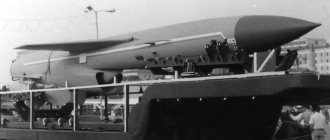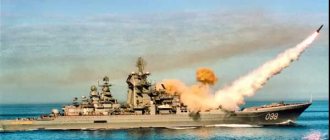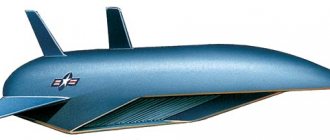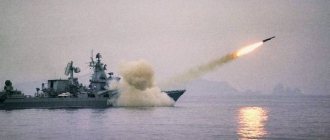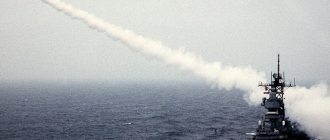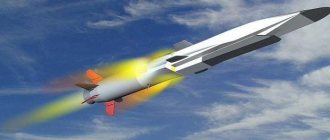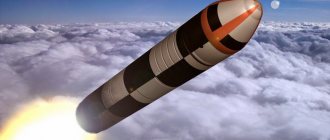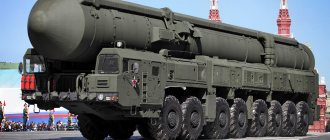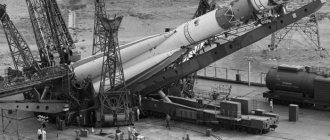Over the gray plain of the sea the wind gathers clouds. Between the clouds and the sea, the Petrel soars proudly, like black lightning.
A. M. Gorky
In his message to the Federal Assembly on March 1, 2022, President of Russia V.V. Putin announced the creation of a nuclear-powered cruise missile. Later this rocket was named "Burevestnik". According to some sources, the missile has the index GRAU-9M730, and NATO assigned it the code designation SSC-X-9 Skyfall. During the message, video footage of a missile system test was shown. We will look at them below.
A few facts
Deputy Minister of Defense, Acting State Councilor of the Russian Federation, 1st class Yu.I. Borisov said that the tests have been carried out, the missile has an almost unlimited flight range and can stay in the air for several days.
Another senior official from the military-industrial complex said that the tests were carried out, the reactor reached its design power and the engine provided the necessary thrust. During the tests, compliance with all radiation safety standards was ensured.
The Ministry of Defense presented two videos showing fragments of testing and the final assembly shop of Burevestnik products. This is where all the available official information is exhausted.
“Break through” any missile defense systems
American partners rejected all Moscow's proposals for joint development of missile defense systems. Moreover, interlocutors in Washington said that “Russia can do whatever it wants,” including creating the latest weapons. The United States will continue to install missile defense on the territory of our neighboring states. We took into account the wishes of our partners, and on March 1, Vladimir Putin presented the Sarmat missile systems, capable of “piercing” any missile defense system, including American ones.
“No missile defense systems are a hindrance to us now. The range of the new weapon is unlimited, the trajectory is unpredictable,” the Russian President said.
The president’s words were reinforced by the Russian Ministry of Defense, showing one of the last stages of testing the complex, which should replace the Voevoda. "Sarmat" can carry warheads of low, medium, high and high power classes.
“Re-equipment with the advanced Sarmat missile system will significantly strengthen the Strategic Missile Forces group and give it new qualitative properties to solve the problems of nuclear deterrence and ensure the security of Russia,” the Ministry of Defense said.
Video: Russian Ministry of Defense
How can this be arranged?
The announcement of the creation of a nuclear-powered rocket caused a sensation in political and military-industrial circles around the world. Enormous interest was shown by the public interested in aviation and missile technology. Opinions are divided: some (experts) argue that this is not possible, others - that the rocket exists. There are often comments in which the data and principle of operation of the Petrel are simply presented in illiterate, and sometimes in completely fantastic categories. Let's try (within the limits of my modest capabilities) to understand these issues.
The main mystery and intrigue in the creation of the Petrel is the nuclear power plant. In the 50-60s of the last century, both the USA and the USSR tried to create nuclear aviation power plants. But the work was curtailed due to technical difficulties, high weight and low efficiency. The main thing is that radiation safety was not adequately ensured. What has changed over the past 60 years?
Types of nuclear aircraft engines
Possible schemes of nuclear aircraft engines
Let us turn to Figure 1. There are four schemes of nuclear aircraft engines. There are also nuclear rocket engines, but they are fundamentally unsuitable for a cruise missile, and I will not consider them.
- The simplest of the given schemes is a nuclear ramjet engine - scheme “G”. But it works effectively at high supersonic speeds (2 ≤ M ≤ 4). The Burevestnik missile is subsonic, so we discard the “D” scheme;
- Schemes “A” and “B” are essentially variations of the same scheme. Scheme "A" is more cumbersome. It is unlikely that it can be placed in the body of a cruise missile, so we discard it.
There are two schemes left for consideration - open “B” and closed “C”. Each of them has its own advantages and disadvantages.
Advantages and disadvantages of schemes B and C
The engine according to the “B” scheme has a simpler design than the engine made according to the closed scheme “B”. It has better thermal efficiency than the "B" engine. The disadvantage is that the outside air directly passes through the reactor core and is exposed to direct radiation. As a result, induced radioactivity appears in the air, resulting in a noticeable radioactive trace.
In this engine, the nuclear reactor plays the role of a combustion chamber in which heat is supplied to the air coming from the compressor. As is known, the efficiency of a turbojet engine directly depends on the temperature of the gases in front of the turbine. The higher it is, the better. But the temperature limit is determined by the heat resistance of the materials from which the fuel assemblies of the reactor core are made. I assume that we have developed new ceramic materials with increased heat resistance. This ceramic contains grains of nuclear fuel.
The Americans used something similar when creating the SLAM cruise missile as part of the PLUTO project. The fuel elements for the SLAM ramjet engine were made from a refractory beryllium oxide ceramic enriched with uranium dioxide as fuel and a small amount of zirconium dioxide for structural stability. The fuel cells were hollow hexagonal tubes with a diameter between flat faces of 7.63 mm, had a length of 102 mm and a hole with an internal diameter of 5.8 mm. The core of the core consisted of 465,000 tubes arranged in the form of 27,000 air channels. The fuel cells were designed for a temperature of 1277 C.
Apparently, our scientists have created similar ceramics with even greater heat resistance. This made it possible to make a powerful small-sized reactor that can be built into the air path of a nuclear-powered engine. By the way, the Poseidon underwater vehicle and the Peresvet laser complex also have a nuclear reactor as an energy source. Perhaps their reactors are built on the same principles.
Scheme “B” is the safest in terms of radiation. In it, external air does not pass through the reactor core and is not directly irradiated. But it is the most complex, difficult and unreliable to work with. Another serious drawback is the lowest thermal efficiency due to the low coolant temperature. But is this really important if the flight range is still practically unlimited, and there are no plans to reuse the product. Nuclear energy is developing, although due to low steam parameters, the thermal efficiency of nuclear power plants is significantly lower than when burning fossil fuels. But scheme “B” has an extremely important advantage - radiation safety - due to the absence of a radioactive trace. This must be taken into account in the light of the statement made about compliance with radiation safety standards.
Another advantage is that the “B” scheme has an aggregate structure, which makes it possible to independently develop and test the energy source - the core with a coolant circulation system and the flow part of the turbojet engine. You can work at different enterprises, separated geographically and departmentally. My assumption is also supported by media reports that the Burevestnik and the underwater Poseidon have similar reactors. I would not be surprised if it turns out that the previously developed and almost unclassified (its mock-up was demonstrated at MAKS-2015) megawatt-class space power plant with a machine generator is of the same type.
I have already mentioned the disadvantages of scheme “B”. This is more complex, therefore less reliable. Big problems arise when choosing the primary coolant. Some designs use liquid metal. And these are great difficulties during operation. But everything is covered by the absence of radioactive exhaust. Therefore, we can conclude: scheme “B” may be used in the Burevestnik cruise missile.
History of the cruise missile Burevestnik (SSC-X-9 Skyfall)
The Russian 9M730 Burevestnik cruise missile began to be developed by Russian scientists in 2001, after the United States decided to terminate the 1972 Anti-Ballistic Missile Treaty. The development of the Burevestnik cruise missile (NATO name is the Skyfall missile) was carried out by the Novator experimental design bureau, but the existence of this missile became known only late - in 2022, during a message to the Federal Assembly.
According to some reports, the main difficulty in developing the 9M730 Burevestnik (SSC-X-9 Skyfall) missile was ensuring its maneuverability - this task was solved only in 2016.
Technical difficulties in creating nuclear propulsion engines
When creating a nuclear propulsion engine, it is necessary to solve many complex technical issues, for example, how to protect ground personnel when servicing the Burevestnik? Looking into the nozzle (diagram “B”), you can see the active zone, which is blocked only by thin turbine blades. How to store Petrel on the ground? The reactor must be securely shut down. When starting, it must be quickly launched and brought to its design capacity. During flight, it is necessary to somehow control the reactor and the nuclear engine as a whole. Most likely, the Petrel flies at low altitude, and the engine is single-mode, without sudden maneuvers in altitude. So the control limits of nuclear engines are small, although they should be. When the reactor operates, powerful radioactive radiation is emitted. It is necessary to protect the on-board electronics from it. If during the flight a decision is made not to strike the enemy, how can the reactor be shut down? Or just sink the rocket in the deep sea of the world's oceans?
There are many questions. However, using new structural materials and the latest achievements in the field of rocket science, our scientists apparently managed to create a compact, powerful reactor, on the basis of which a nuclear turbojet engine (NTRE) was built.
When using scheme “B”, air passes through the reactor core and receives induced radiation. This creates a radioactive trace. This is the law of nature. There's no escape from it. In this regard, the statement about compliance with radiation safety standards requires further clarification. After all, radiation safety standards are different: for the civilian population - one, for workers in the nuclear industry - another, and when testing nuclear equipment (or weapons) - another.
I think that the Burevestnik uses a nuclear turbojet engine according to scheme “B”, as it is simpler. Although maybe I'm wrong.
Panorama of the assembly shop where the Petrels are assembled. Ekaterinburg OKB "Novator"
It can be seen that the rocket is painted red, the width of the fuselage is greater than the height. The wing has a moderate sweep. The missile is partially covered with a tarpaulin (or other material) - maintaining secrecy. The tail section appears to be undocked from the rocket.
The photo shows that the wing has a moderate sweep. This wing is not designed for supersonic speeds. Therefore, the rocket is unlikely to use a ramjet engine. The wing has a rather thin profile, so I estimate the rocket’s speed at 750-900 km/h.
Another video shows fragments of the Burevestnik tests.
Petrel's trials. The launch was carried out from a mobile launcher. The rocket is painted red, the launch boosters are white. It is impossible to make out in the photo whether the wing is open or not.
"Vanguard" is already in the series
The Avangard complex with fundamentally new equipment - a gliding winged warhead - has already been put into mass production.
Avangard can maneuver both laterally and vertically on the way to the target, which makes its trajectory unpredictable for missile defense systems. The warhead flies below the minimum altitude for intercepting atmospheric missile defense fire.
“Its interception by short-range missiles is also unlikely due to the limited capabilities of targeting missiles at a high-speed maneuvering target and the use of a modern complex of missile defense countermeasures by the planning wing unit,” the ministry explained, publishing a video from the test site.
Video: Russian Ministry of Defense
By the way, a couple of weeks ago the American National Interest allegedly tried to dissuade Russia from the latest weapons. They say that the Avangard systems - the same Russian hypersound - are not needed by Russia, since in the event of a war with the United States, already known models of missiles will be enough to destroy the enemy. Moscow has 528 land- and submarine-launched ballistic missiles. And for the United States to cease to exist as a state, a small fraction of these weapons is enough. Russian military experts have come to the conclusion that Washington is persuading itself, while trying to lull Moscow's vigilance.
Petrel's Trials
The launch took place at a nuclear test site on the island. Novaya Zemlya, near the village of Pankovo at the end of 2022. During the flight, a nuclear turbojet engine was launched. The flight was considered successful. According to the American press (with reference to intelligence), four launches were previously carried out in Kapustin Yar. All unsuccessful. Apparently, the Americans mistook the throw tests for unsuccessful flights. Carrying out throw tests is a common practice of our military-industrial complex. They check the process of the missile leaving the launcher, the operation of ground equipment, work technology, etc.
Petrel in flight. One can distinguish a swept wing of high aspect ratio, a large launch accelerator and a torch from its operation. Quite a large keel located below
During the flight, the rocket was accompanied by several aircraft from which filming was carried out. Let's take a close look at the shot of the Petrel flying. A moderately swept wing with high aspect ratio is visible. High aspect ratio provides greater flight range. The rocket has two large launch boosters on the sides. The boosters are most likely solid fuel. The high keel extends downwards with a moderate sweep. To ensure that the stabilizer does not fall into the zone of the torch from the working starter, it is probably made in the form of the letter “V”. Taking into account all of the above, I sketched out a possible design for the Burevestnik rocket.
Possible scheme of the Burevestnik missile launcher
Problems of navigation, control and guidance
No less complex issues must be resolved when creating a flight control system. In my humble opinion, this is only possible using elements of “artificial intelligence”. When flying over the ocean, there are no landmarks. Therefore, navigation there is performed using GLONAS. We exclude the GPS system: in war conditions it will not be available to us. If GLONAS signals are lost, for example due to enemy influence, navigation must be performed on the basis of an autonomous astro-inertial system. Perhaps it was developed on the basis of the L-14MS astroinertial system installed on the Tu-160 bomber.
When entering the continent, it is possible to adjust the navigation system based on ground landmarks. Next, the flight occurs using a terrain tracking system. The operating principle of the system is that, based on photographs taken using reconnaissance satellites, three-dimensional maps of the flight of cruise missiles to various objects are compiled. Information about the selected route is stored in the memory of the on-board computer. Several correction areas are selected along the route. For these areas, a particularly detailed 3D model of the underlying terrain is compiled. In correction areas, the cruise missile uses an on-board radio altimeter to monitor the terrain and compares this data with the parameters stored in the on-board computer. Then the location of the rocket, the amount of deviation from the planned route and the method for correcting existing errors are automatically determined. Next, the rocket flies in radio silence to the next correction area, where the procedure is repeated. And so on until the target is hit. The GLONAS system in this case plays a supporting role - it provides the cruise missile with flight at low altitudes, adapting to the terrain. This increases stealth, makes it difficult for the enemy to detect the missile and increases the accuracy of hitting the target. It is clear that several routes and several potential targets can be stored in the computer’s memory. Target selection is carried out by command from the ground.
In conditions of a multi-day flight (let's say that the Burevestnik can fly for a week), another problem arises - during the flight the rocket can get caught in a storm. It is clear that it is better to bypass the hurricane zone. Is there equipment on board the Burevestnik to detect hazardous weather phenomena? Time will show. In the animation of the Moscow Region, shown during the performance of V.V. Putin, it was shown how the missile bypasses enemy air defense zones. Question: by what means will the Petrel detect these zones? Or will the rocket receive this data from the ground?
Concept of application and political-economic aspect
From all of the above, I conclude that the Burevestnik missile with a nuclear power plant exists. At least one successful flight completed (early 2022). But the advent of full-fledged military weapons is still very far away. It is necessary to carry out a lot of testing and related improvements, improvements and upgrades. There is a huge amount of work ahead.
In connection with the tests, another question arises. The duration of the flight will gradually increase, then it will become necessary to test the Burevestnik for its full range. That is, you need to fly to the southern regions of the Atlantic or Pacific Ocean and return back. A problem arises here: it’s one thing to cut circles around the Novaya Zemlya archipelago (our territory - we do what we want), and a completely different thing to fly over the neutral waters of the oceans, leaving a radioactive trail behind us. The international community may not like this. Here it is necessary to carefully weigh all the risks and possible consequences of such actions.
It is clear that a cruise missile with a nuclear-powered engine is much (perhaps an order of magnitude) more expensive than a conventional intercontinental-range cruise missile. I have no doubt that conventional ground-based intercontinental-range cruise missiles will be created. Existing missiles can be increased in size, drop tanks can be attached, and so on. Then the question is - what is the advantage of the expensive Burevestnik over a conventional cruise missile? There is only one advantage - unlimited range and flight duration (about a week).
Here we move on to the possible concept of combat use of the Burevestnik. Take a look at the map. We are surrounded by American bases on all sides.
NATO military bases around Russia
The enemy can attack us from any direction. We, in turn, can respond to the potential enemy mainly from the northern direction. From the west and east we can respond with submarine-launched ballistic missiles. The only direction inaccessible to us is the South. We cannot place submarines there: South America is in the way. It can be assumed that the potential enemy has the weakest air defense from the south. It is from this direction that it is possible to launch a retaliatory strike using a Burevestnik missile with a nuclear power plant.
The scheme for using the Burevestnik missile launcher could be as follows: it is a “Doomsday” weapon, that is, a weapon of the Third World Nuclear Missile War. It is unsuitable for ordinary conflicts of medium intensity.
As I was taught at the military department, before the start of the Global War there will be a short pre-war period. During this period, international relations will deteriorate to the extreme, the armed forces will be put on full combat readiness, general mobilization will be carried out, the population will be evacuated, and so on. It is during this period that the Petrels can be launched into the air. But it is necessary to do this in such a way that the enemy does not regard the fact of launch as the beginning of the first strike.
They (Petrels) will go to the deserted southern regions of the Atlantic and Pacific Oceans, and there they will circle awaiting command. In this case, if the enemy delivers the first, disarming strike, destroys all our ground-based missiles, airfields, liquidates all of our military and political leadership, then the Petrels will still remain intact, turn north and attack the enemy. The first retaliatory strike will come from our submarines, and then cruise missiles will fly up. Undoubtedly, some of the Stormcloaks will break through to the targets and inflict unacceptable damage on the enemy. The scenario is terrible, and it’s better not to let it get to that point. The lives of millions of people are not worth any political differences. If war can be averted at the last moment, the Stormcloaks could be drowned in the deep waters of the ocean.
Product without a name. Why does Russia need a nuclear-powered cruise missile?
On August 8, an accident occurred at a Ministry of Defense facility in the Arkhangelsk region.
The military initially reported that the incident occurred during a "test of a liquid-propellant propulsion system," although a brief increase in background radiation in the area of the accident indicated that the incident may have been related to a radiation source. On August 10, this was officially confirmed by a press release from the state corporation Rosatom: “The tragedy occurred during the period of work related to the engineering and technical support of isotope power supplies on a liquid propulsion system,” states the document, which also reports the death of five employees of the corporation and burns three more had varying degrees of severity. Nuclear weapons expert Geoffrey Lewis has suggested that the accident occurred during a failed test of the Russian Burevestnik nuclear-powered cruise missile, a hypothesis based on a study of satellite imagery and other data, in particular, information that off the coast near the accident site There is a ship "Serebryanka", designed to collect liquid nuclear waste. Rosatom’s wording does not speak of a reactor, which is presumably an integral part of the Burevestnik, but rather of an isotope power source, however, discrepancies are possible here.
We are again publishing a text about the Burevestnik missile, prepared in March 2022 - a few days before this cruise missile with a nuclear propulsion system received its “bird” name following the results of an open competition of the Russian Ministry of Defense.
On March 1, 2022, Russian President Vladimir Putin, in an address to the Federal Assembly, announced the creation of the latest strategic weapons systems, presented as a response to the construction of a missile defense system by the United States.
Putin listed the following:
- Missile system with a heavy intercontinental missile "Sarmat": there are "virtually no restrictions on range", "capable of attacking targets both through the North and South Pole."
- Cruise missile with nuclear power plant.
- Unmanned underwater vehicles with intercontinental range at speeds “multiple times faster than the most advanced torpedoes.”
- Hypersonic aircraft-missile complex "Dagger". The high-speed aircraft delivers the missile to the release point “in minutes.” The rocket, which “exceeds the speed of sound ten times,” maneuvers throughout all phases of its flight. Range of more than two thousand kilometers, nuclear and conventional warheads. Since December 1 - on experimental combat duty in the Southern Military District.
- A promising strategic missile system with a gliding cruise unit "Avangard". “Goes to the target like a meteorite”: the temperature on the surface of the block reaches 1600–2000 degrees Celsius. The tests have been successfully completed. Serial production has begun.
- Laser weapons. “Since last year, the troops have already received combat laser systems.”
In the United States, Putin's statements were met with skepticism, linking them with the upcoming presidential elections in Russia. NBC cited the opinions of experts and unnamed officials that the weapons named by Putin are not a surprise to American experts and that some of them are not ready for use on the battlefield, in particular, a nuclear underwater torpedo. The Pentagon assured the Americans that the US military is fully prepared [to repel such threats].
Unpredictable flight path
A review of US nuclear posture published in February states:
“In addition to modernizing the “legacy” of Soviet nuclear systems, Russia is developing and fielding new nuclear warheads and launch vehicles... Russia is also developing at least two new intercontinental systems, a hypersonic glide vehicle, a new intercontinental, nuclear and nuclear-powered underwater autonomous torpedo.”
That is, the review mentions at least three types of the six weapons listed by Putin. It is not entirely clear whether “Dagger” or “Vanguard” is meant by the name hypersonic glider - rather, “Vanguard”. Laser weapons are not strategic and therefore do not cause much debate. The underwater torpedo appears to be the same Project Status-6, pictures of which were allegedly accidentally shown on Russian television in a report on Putin's meeting with the military in 2015. Thus, the only real surprise could be a nuclear-powered cruise missile. And it was this missile that, of all those listed by Putin, became the subject of the greatest discussion.
This is how the project was described by Putin: a small-sized, ultra-powerful nuclear power plant has been created, which is housed in the body of a cruise missile like the latest Russian air-launched Kh-101 missile or the American Tomahawk and has a “virtually unlimited” flight range - because of this (and thanks to “ unpredictable flight path,” as Putin put it) it is capable of bypassing any interception lines. At the end of 2022, its successful launch took place at the Central Test Site of the Russian Federation. During the flight, the power plant reached the specified power and provided the required level of thrust.
As illustrative material at Putin’s speech, a video was shown in which a missile skirts interception zones in the Atlantic Ocean, circles the American continent from the south and goes north.
There is some ambiguity here: Putin is talking about installing a nuclear engine on missiles like the X-101, and this is an air-launched missile. In the video, the launch is made from the ground.
Attempts to create a nuclear-powered cruise missile date back to the middle of the last century, in the United States this is the Pluto/SLAM project. A compact nuclear reactor is installed on a rocket and during flight heats air taken from outside, which is then thrown out through a nozzle, creating thrust.
Project SLAM (illustration)
The advantages of such a project: there is no need for a supply of any fuel other than nuclear, that is, the combination of “nuclear reactor + air as the working fluid of the engine” has an almost unlimited power reserve - and this coincides with the description of the Russian president.
In 1964 the project was finally closed
The disadvantages that forced the Americans to abandon the project: the reactor, in order to be compact enough for a rocket, lacks protection, is cooled directly by flowing air, which becomes radioactive and is thrown out. Testing such a missile is extremely problematic - it emits a huge amount of heat, makes a very loud sound and covers the area over which it flies with a plume of radioactive fallout. If something happens to the rocket, an unprotected nuclear reactor could fall in a populated area. (For example, it is difficult to imagine a nuclear-powered cruise missile strike similar to the Kalibr missile strikes launched by Russian ships from the Caspian Sea in 2015 against targets in Syria.)
And yet, the engines created as part of the project were tested on stands - they demonstrated high power in line with what was expected, and the radioactivity of the exhaust was lower than the engineers expected. However, in 1964, the project was finally closed: it required large expenses, any aerial test of the missile would be extremely dangerous, and most importantly, doubts arose about the feasibility of cruise missiles of this type - by this time it became clear that the basis of the strategic nuclear arsenal was destined to become intercontinental ballistic missiles. rockets. Nuclear-powered rockets were being developed in the USSR and Great Britain around the same years, but they did not even reach the bench testing stage.
How can a nuclear-powered rocket be constructed?
Let's start with the sizes. The President mentioned that its parameters are comparable to the Tomahawk and X-101 missiles. The Tomahawk has a diameter of 0.53 cm, and the X-101 (it is not round in shape) has a described diameter of 74 cm. For comparison, the diameter of the SLAM missile was supposed to be more than three meters. Independent nuclear technology expert Valentin Gibalov believes that the parameters of the new Russian development may be somewhere in the middle, and that effectively fitting a design with a nuclear reactor into a diameter of 50–70 centimeters is very difficult and hardly makes sense. Based on the test video, taking into account the size of the launcher, one can estimate that the diameter of the new missile is about 1.5 meters.
X-101
What's inside this pipe? The simplest option is the so-called ramjet engine, when air entering through the air intake at the front passes through the reactor, heats up, expands, and leaves the nozzle at a higher speed, creating jet thrust. The SLAM project was based on this principle, however, this scheme is far from the only one. The new development could use some version of a turbojet engine; the air could be heated not directly, but through a heat exchanger - the reactor could generate electricity and power an electric motor that rotates the propeller.
Unmanned drone with long wings or corn husk
No matter how exotic this option sounds, it could work, only such a rocket would fly at a maximum speed of 500 km/h and would outwardly look more like an unmanned drone with very long wings or... like a corn farmer. The fact is that a nuclear installation that additionally converts thermal energy into electrical energy will have a very large relative mass for a given power. “Let’s say there is a project that is now classified, but until 2016 was quite widely published - this is a project for a megawatt (megawatt is useful energy with 4 megawatts of thermal energy) RUGK reactor and a TEM (Transport Energy Module) installation on its base, it is everywhere called a space-based nuclear tug. In this project, the weight of the reactor plant plus the energy conversion system is almost seven tons with a power of 1 megawatt. It can be compared to the AN-2 aircraft: it has a maximum take-off weight of approximately seven tons and an engine power of approximately 1 megawatt. It turns out that if we have nothing but a reactor and turbogenerators, then something like the AN-2 will come out,” says Gibalov. The maximum speed of the AN-2 is 258 km/h, such a missile is unlikely to be needed by the Russian army.
An-2
Another exotic option was mentioned in a comment to the Federal News Agency by Sergei Sudakov, a professor at the Russian Academy of Military Sciences: “We are now offering a completely new technology - this is a very compact engine of a completely new generation... This is all about cold reactions and cold nuclear fusion. These engines are completely different, and they have nothing to do with the installations that the United States developed in the 50s.” An expert, apparently unrelated to the project, explains that Russian engineers managed to create an engine using “low-enriched uranium” with high efficiency, and there will be nuclear “exhaust”, but it will be minimal. “We have made a rocket that flies at low temperatures and with virtually minimal pollution,” Sudakov said.
If the military suddenly has such an excellent source of energy
Cold thermonuclear fusion, that is, a thermonuclear reaction that occurs at relatively low starting energies (in a classical thermonuclear reaction, such as a thermonuclear explosion, the fuel must initially be heated to a very high temperature - for example, by a laser or explosion) is a fringe theory. The scientific consensus is that cold thermonuclear fusion is impossible in principle; a few adherents of this approach from time to time loudly declare that they have achieved success, but no one has yet been able to repeat their experiments. There is another argument against the cold thermonuclear in the new rocket - it could be used much more effectively for other military purposes: “What is the point of then numerous state-funded projects of autonomous nuclear power plants for the Arctic, if the military suddenly has such an excellent source of heat and energy, and then they wouldn’t carry fuel on airplanes, as is now happening for diesel engines,” notes Gibalov.
Design of the SLAM project rocket
But other, more traditional approaches, according to Gibalov, are too complex for an engine that must operate for a very long time and under conditions of harsh radiation:
“For example, an air jet engine with a turbine requires extremely complex high-precision mechanics, which, if put into the conditions of a nuclear reactor, will not work for any long time. It is necessary to sort through all the components of such a combined engine and carry out extensive research on each component - what materials should be used to replace it, how to improve it. The further we delve into the details of such a possible more complex option, the clearer it will be that such a development is comparable, if not larger, in scale with the USSR's development of nuclear rocket engines for space rockets, and they required the construction of several nuclear centers with reactors, stands at Semipalatinsk test site, where hydrogen was blown through a nuclear reactor. All this dragged on for about 20 years, about 25 – working out. And it was very labor-intensive and very resource-intensive. I think that any other option except straight-through is about the same.
Oil is more likely to flow from a Formula 1 engine than from an Opel.
According to the expert, the new development is most likely a continuation of the ideas of the 1960s, primarily the ramjet engines of the SLAM project. Gibalov claims that modern materials and new technologies for the production of fuel elements make it possible to make such a rocket much cleaner than 60 years ago:
– All reactors are designed in such a way as to retain fission products, that is, radioactive dirt that is formed during operation. They are airtight in this regard. Here, of course, there is a certain difficulty: the higher the temperature, the more difficult it is to do this, that is, the walls begin to flow. But, it seems to me, in principle this problem can be solved. It can be assumed that in an accident-free version, such a direct-flow reactor is comparable in emissions into the air with a closed reactor with heat exchangers and a secondary circuit.
However, one can hardly expect that such complex and completely new equipment will always function properly, especially at the testing stage. “Oil is more likely to flow from a Formula 1 engine than from an ordinary Opel,” explains Gibalov.
Name
A name for the Russian nuclear-powered cruise missile has not been invented - and even a competition has been organized on what to call it. However, military observer Alexei Ramm in Izvestia puts forward a version that we are talking about the product 9M730 of the Novator Design Bureau, one of the developers of Russian cruise missiles. At the same time, the article itself mentions that Novator specializes in ground-based and sea-based missiles, and “air-launched products” are developed by Raduga. And the X-101 missile mentioned by Putin is precisely air-launched.
The Novator products numbered 9M728 and 9M729 are indeed cruise missiles, one for the famous Iskander missiles, the other a ground-based analogue of the X-101 mentioned by Putin. And indeed, judging by the government procurement website, the product is in a state of active development. However, there is no evidence that this is indeed the missile announced by Putin.
The article provides a description of a rocket with a nuclear engine by military historian Dmitry Boltenkov: “On the sides of the rocket there are special compartments with powerful and compact heaters powered by a nuclear power plant.” This is somewhat different from the concept that air flows directly around the reactor, and assumes some kind of heat exchange system.
Eccentric types of nuclear weapons
American Russian weapons expert Michael Kofman, in his blog, agrees with Ramm’s assumption that the nuclear-powered missile is the 9M730. Kofman believes that we are talking about a reactor without protection, based on the size and weight of the rocket.
He also quotes former Secretary of Defense Ash Carter as saying in a 2022 article: “Russia is investing in new ballistic missile submarines, heavy bombers, new ICBMs... But they are also combined with new concepts for the use of nuclear weapons and some new and even eccentric types of nuclear systems.” weapons,” which, according to Kofman, now play in a new light.
Another weapons expert, Jeffrey Lewis, writes in an article for Foreign Policy that all the systems unveiled by Putin were known to the Barack Obama administration: “Even the cruise missile, which, as I now understand in hindsight, had been hinted at for some time.” American officials at the time."
Were there any tests?
CNN and Foxnews reported, citing unnamed officials, that the missile announced by Putin is still in the development stage and that the United States recently witnessed an attempt to launch such a missile that ended up crashing in the Arctic (although it is not entirely clear how to distinguish a successful missile launch from launch, ending with its fall - and in any case, in real tests of the rocket at the end of the flight the nuclear reactor should crash into the surface of the Earth at high speed).
According to Putin, the tests took place at the Central Test Site. Ramm in Izvestia cites the opinion that this is a training ground in the village of Nenoksa, Arkhangelsk Region (State Central Marine Test Range of the Navy). At the same time, the Central Nuclear Test Site of the Russian Federation is located on the Novaya Zemlya archipelago. Kofman also suggests that the launch shown in the video took place on Novaya Zemlya.
The first underwater nuclear explosion in the USSR and the first nuclear explosion on Novaya Zemlya on September 21, 1955. Test of a T-5 torpedo with a power of 3.5 kilotons at a depth of 12 m (Chernaya Bay).
In this regard, the authors of the Warzone project recall the mysterious release of the radioactive substance iodine-131 into the atmosphere in February last year, the source of which was the Kola Peninsula in northern Russia. The release of iodine-131, they say, was recorded - among dozens of other isotopes - during nuclear engine tests in Nevada in the 60s.
Four isotopes of iodine and two isotopes of ruthenium at once
True, the release of one isotope of iodine without other radionuclides can hardly be a consequence of testing a “dirty” nuclear-powered rocket.
“Most likely, there would be at least two isotopes and even more,” explains Gibalov. – When we have a leak, roughly speaking, from an operating reactor, we immediately see four isotopes of iodine and two isotopes of ruthenium (but this, apparently, does not apply to the leak of ruthenium in the Urals last year. – RS). If we have a certain amount of iodine flow through the wall, then all these four isotopes travel together. And this is all very well monitored and determined, the method is widely used. My opinion: in the case of real flights, even on Novaya Zemlya with the nuclear engine turned on, namely flights, and not ground bench tests, monitoring stations will notice them - however, provided that the reactor is “flowing”.
During normal operation, the expert claims, it will be quite difficult to detect traces of its work: “Yes, air activation still occurs. Unfortunately, the longest-lived isotope that can be detected is argon-41, which has a complete decay period of approximately two hours. The USA has planes that are equipped with detectors of all kinds of activation products, decay products. But, I think, with such an aircraft it is possible to record the trail of a rocket, practically only by flying through it for not such a long time.” But the absence of leaks in a new nuclear engine, as mentioned above, is extremely unlikely.
Putin said in his speech that successful tests were carried out at the end of last year. Vedomosti made a strange addition to this information, reporting, citing a source close to the military-industrial complex, that radiation safety during rocket testing was ensured, since “the nuclear installation on board was represented by an electrical mock-up.”
From a technical point of view, a reactor is just a heater
Could it be possible to launch a prototype rocket that uses an electric plant instead of a nuclear engine? Gibalov says that this is not only possible, but also quite logical:
– From a technical point of view, a reactor is just a heater; it is very easy to replace it with fuel elements made of wire through which current flows, with conventional TEMs. This would be a very reasonable decision during the first flights of the rocket to understand how well the aerodynamics and control system are designed. We simply throw away, say, a future warhead, and replace it with half a ton of batteries, which provide the thermal equivalent of a reactor, perhaps of reduced power. They do this for a very short time, 10, 20, 30 seconds, no more than a minute, but they allow you to explore it all without fear of disaster right on the first flight.
In an interview with NBC journalist Megan Kelly, Putin said that the tests of the new weapons went well, “some systems still need to be worked on, tweaked, and some have already entered the troops and are on combat duty.” Asked to answer on the record the question “do you have a working nuclear-powered intercontinental missile that has successfully passed testing,” Putin said: “They all passed it successfully. It’s just that different systems are at different stages of readiness.”
Everything is 100% closed
Gibalov calls the creation of a cruise missile with a nuclear power plant a theoretically solvable task, given the current level of technology, but still extremely expensive and resource-intensive. He names indirect arguments indicating that in reality the missile that Vladimir Putin presented to the Federation Council may not exist:
“Unlike other new types of weapons announced by the president, there were no traces of this design. For example, the development of Sarmat has been known for a long time. Here and there, design elements, estimates, scientific articles came out, there was some kind of trail of indirect signs that such development was underway. One can, of course, explain the absence of this trail in the case of a cruise missile by the fact that the nuts were really tightened here. For example, it is impossible to find anything on the development of modern nuclear weapons, what weapons are being developed, what technical principles are used there - this is all absolutely 100% closed. But there is not only a nuclear part, there is also a missile and cruise part. And, as it seems to me and other colleagues, there would be some traces. I think at least this project is at a fairly early stage of development.
Strategic Balance
William Perry, US Secretary of Defense in the Bill Clinton administration and a disarmament expert, writes in Politico that the new weapons announced by Putin do not change anything in the balance of nuclear deterrence: Russia does not need to invent new means to overcome US defenses by “entering from the south.” ”, because it already has all the capabilities for this: the missile defense system, as Washington has repeatedly stated, is not able to withstand the massive launch of intercontinental missiles, its goal is individual salvos from pariah states like North Korea, and Russia and the United States are already have the ability to destroy each other. Perry is concerned that the US could be drawn into this latest race with Russia to see who has the bigger nuclear button.
And you are in the mud, and the pig is happy
Lewis says the same thing: “An arms race with the Russians is pointless. The Russians are taking it to themselves. A race with the Russian military-industrial complex is like a fight with a pig: both you are in the mud and the pig is happy.” Kofman does not believe that Russia needs new weapons to ensure a viable nuclear deterrent, nor that they fundamentally change the military balance with the United States. According to the expert, “Russia is not confident in its conventional [military] capabilities in the coming years or ever.”
The speech of the Russian president contained a clear message: “no one in the world has anything like this yet,” “no one really wanted to talk to us, no one listened to us. Listen now." But it is interesting that Putin uses only the development of US missile defense as a justification for new Russian weapons, without discussing, for example, the improvement of US ballistic missiles, which, as experts argue in the article “How the modernization of US nuclear forces undermines strategic stability,” could change the balance of power deterrence, especially given the limitations of Russia's early warning system.
In the same speech, Putin said that “the updated review of US nuclear strategy... lowers the threshold for the use of nuclear weapons” and that Russia can use nuclear weapons “only in response to the use against it or its allies... of weapons of mass destruction or in the event of aggression... when The very existence of the state is at risk.”
However, the United States sees Russia as “lowering the threshold” in the use of nuclear forces: “Russia’s confidence that by being the first to use nuclear weapons, including low-yield weapons, one can gain such an advantage is partly based on Moscow’s idea that the possession A greater number and variety of non-strategic nuclear weapons provides superiority in a crisis situation or in a more limited conflict. Recent statements by Russia regarding this emerging doctrine of the use of nuclear weapons can be regarded as Moscow lowering the “nuclear threshold”, crossing which one can be the first to use nuclear weapons... Forcing Russia to abandon such illusions is a strategic task of paramount importance... Increasing the flexibility and diversity of US nuclear capabilities, including including allowing the use of low-yield nuclear weapons is important for maintaining the ability to prevent aggression on a regional scale. This will raise the nuclear threshold and make potential adversaries realize that they cannot gain an advantage through limited nuclear escalation, which in turn will reduce the likelihood of the use of nuclear weapons.”
Radio Liberty
Financial component
Let's return to the financial aspect. Weapons are very expensive. After the Burevestnik is put into service, costs will be required for training personnel and conducting training launches (do not forget about the possible radioactive exhaust). It is possible to conduct exercises with real launches. And all this is money, money, money... In general, the expenses are very large.
I hope that in the end the US will agree to talk to us as equals. You still have to negotiate. And here, while we have an advantage in this area (nuclear rocket engine), maybe it’s worth exchanging Burevestnik for equivalent concessions from the United States? Only politicians and military experts can answer this question.
Instead of an afterword
Moscow, while developing its own weapons, does not violate any of the norms of international law. We do everything possible to ensure our own safety. At the same time, the country is not being drawn into a new arms race, no matter how some so-called partners in the world might want it.
“To those who are trying to develop their weapons, trying to get a unilateral advantage from Russia, issuing illegal and complex restrictions and sanctions in order to restrain the development of our country, including in the military field, I will say: everything that you tried to prevent by pursuing such a policy , it's done. And it was not possible to contain Russia,” Vladimir Putin expressed this position more than once, emphasizing that Moscow does not intend to retreat from the decisions made.
“Nobody wanted to talk to us. Nobody listened to us. Listen now,” Putin said, presenting the latest weapons. Photo: globallookpress.com.
